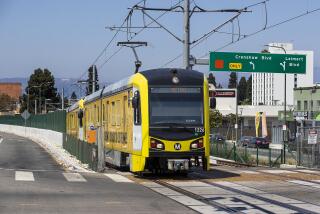Norwalk ‘Very Disappointed’ : Study Puts Commerce on Inside Track for Amtrak
- Share via
Commerce will become the site of an Amtrak intercity train station if the Los Angeles County Transportation Commission goes along with a staff recommendation next month, a commission official said.
Commerce and Norwalk were the only cities left in the competition for the station, which the commission had designated for the Southeast. Pico Rivera dropped out of the running last month.
“Commerce basically was superior in all” categories of the commission’s criteria, including cost, track modifications, financing and ridership base, said Craig Johnson, a rail development officer for the commission.
Ray Ramirez, assistant director of community development in Commerce, said, “I think this is the crucial recommendation. This is what we’ve all been waiting for.”
Norwalk Plans Pitch
But Ken Montgomery, public works director in Norwalk, said his city will make another pitch when the commission’s Rail Transit Committee votes on the recommendation at its Feb. 5 meeting.
“We’re very much disappointed, but the fight is not over,” Montgomery said. “We’ll hopefully be able to speak at that meeting. About all we can do is wait for that meeting.”
The decision to recommend Commerce came during a meeting last week when the final proposals from the cities were reviewed by officials of the commission, Amtrak and the Atchison, Topeka & Santa Fe Railway. The full commission is expected to select a site next month, and Johnson estimated that the Amtrak station would open in about a year.
A crucial factor in Commerce’s favor was cost. Commerce proposed building the station for about $200,000, while Norwalk’s price tag was about $887,000. Establishing a station in Norwalk would require about $550,000 in track improvements, but only about $10,000 in Commerce.
Commerce also planned to finance the station with money from its Redevelopment Agency, while Norwalk wanted to rely on funding from the commission or the state. Johnson said that predominantly industrial Commerce, to which 85,000 people commute daily, would have a better ridership base than residential Norwalk.
The Southeast station is intended to upgrade Amtrak’s Los Angeles-San Diego route, which now has no stops between Union Station in downtown Los Angeles and Fullerton in Orange County. However, the station will be designated as “intercity” rather than “commuter,” with trains stopping a maximum of twice daily each way. None of the stops will be during morning or evening rush hours.
Santa Fe officials want to minimize interference with the railroad’s main freight line in the Southeast, where more than 40 trains, including 18 Amtrak trains, pass through daily.
The Commerce site is in a mostly industrial area at Garfield Avenue and 26th Street, less than a mile from the Santa Ana Freeway. The Commerce proposal is “Spartan,” Ramirez said, with a 902-foot concrete platform, two bus shelters and parking for about 20 cars.
There would also be a waiting area for four buses, where city and RTD service could overlap, he said.
Norwalk proposes a 1,000-foot platform with bus shelters and parking for 67 cars. The station would be on Shoemaker Avenue east of the city’s Civic Center complex, and about a mile south of the Santa Ana Freeway.
The unknown part of the station equation for both cities is the cost of land acquisition.
Commerce would put its station on two acres of Santa Fe land that it would buy, lease or exchange from the railroad. Ramirez said that if the station proved to be successful, Commerce would try to acquire another five acres on the site for an expansion. He declined to speculate on land acquisition costs, saying city officials are still negotiating with the railroad.
Norwalk would build its station mostly on an acre bought or leased from the railroad, but the city also would have to acquire a small parcel of privately owned land and contribute 18,500 square feet of city land. Officials estimate land acquisition costs alone at about $800,000, bringing Norwalk’s total costs for the station to about $1.7 million.
Despite the higher price tag in Norwalk, Montgomery said his city’s location is better.
“Our location is superior because it has a population base (of about 500,000 within five miles) where Commerce has a commercial base around it. This is an intercity service, not a commuter service,” Montgomery said.
He added that it would not make sense to build another stop so close to Union Station in downtown Los Angeles. Commerce is about five miles from that station, he said.
More to Read
Sign up for Essential California
The most important California stories and recommendations in your inbox every morning.
You may occasionally receive promotional content from the Los Angeles Times.













